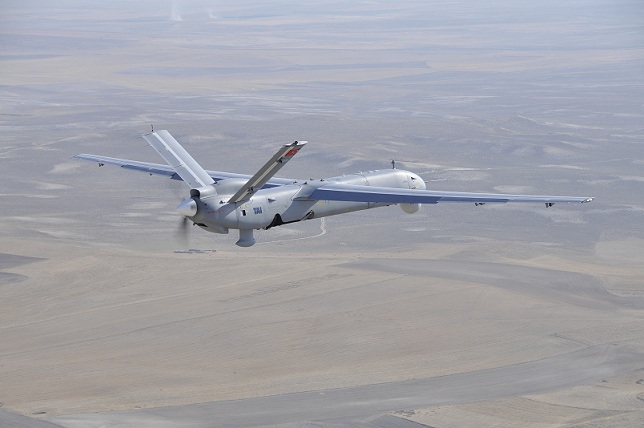
TAI Anka (Phoenix) is Turkey’s first indigenously designed and built Medium Altitude Long Endurance (MALE) UAV. Developed by Turkish Aerospace Industries, ANKA will make its public debut on June 29th. (Source: Turkish Aerospace Industries)
After years of relative quiet, 2011 was one of the bloodiest in the recent history of the Turkey-Kurdistan Workers’ Party (PKK) conflict. Last week, eight Turkish soldiers and 10 PKK militants were killed following a cross-border attack by the PKK on an outpost in the eastern province of Hakkari. The recent clashes came at a time of growing national and international pressure on Ankara to find a political solution to the conflict, which has claimed more than 30,000 lives since the early 1980s.
The Dağlıca attack also coincides with Ankara’s renewed interest in purchasing armed drones from Washington. During the NATO Summit in Chicago last May, Turkish President Abdullah Gül reportedly asked U.S. President Barack Obama to help with the drones, which Ankara has been trying to buy since 2009. Last week, Turkish defense officials brought the issue to the attention of their American counterparts at the annual Turkish-American conference in Washington. The U.S. Congress, however, opposes the sale of drones to Turkey because of Ankara’s worsening relations with Israel.
Last year, Washington agreed to deploy four Predator drones at Turkey’s İncirlik airbase as part of efforts to continue surveillance of the PKK. Together with Turkey’s own fleet of drones, they monitor the border areas to gather intelligence on PKK movements. Ankara, however, wants to buy two Predators and four Reapers – the type of armed drones the U.S. has used in places like Yemen, Somalia and Pakistan to target militants. The Predator, which is the most commonly used drone by the U.S., can fly for about 40 hours and, when weaponized, can carry two air-to-ground missiles. The Reaper is a larger and more powerful drone. Compared to the Predator, it is faster, can fly at higher altitudes and carry more missiles.
In Turkey, armed drones are seen as a necessary measure against the PKK, and Turkish officials are conducting intense diplomatic efforts to convince lawmakers in Washington to approve the sale. However, will spending millions of dollars on new drones help solve Turkey’s number one problem?
To be sure, armed drones have their advantages: They are cheaper to operate and minimize the risks associated with manned aircraft. They reduce the “kill chain” – the process of identifying and destroying a target. In a non-drone scenario, aerial surveillance would send intelligence on a target to an operations center, where officers or intelligence officials discuss or consult with their senior officers for a decision. Then, air assets would be sent to the area to destroy the target. This process, sometimes taking several hours, may fail to prevent an attack. With an armed drone flying over the suspected target, the kill chain is significantly shorter as the drone can help identify and destroy a target within a matter of minutes.
Yet, while the advanced cameras on these drones can provide clear video imagery, there is always room for mistake. The drone pilots may not accurately identify whether the individuals are militants or civilians. Last December, a drone provided video imagery of suspected PKK militants near the Turkish border. With this information, air force jets were sent to the area and attacked the group, killing 34 civilians in the eastern village of Uludere.
Turkey’s interest in armed drones and its pressure on Washington for their purchase also show that not much has changed in how the country does military acquisition. In 2010, I wrote the following in an opinion piece for the Hürriyet Daily News:
“The country often faces difficulty in procuring the right equipment when needed or keeping up with the fast-changing threats to national security. That is why, while billions of dollars are spent on early warning aircraft [which has no use against the PKK] and submarines [that the country literally buys for virtual threats], urgent operational requirements such as mine- and ambush-resistant vehicles or attack helicopters take almost a decade to purchase.”
Turkey often follows foreign trends in its acquisition policy, wasting resources in purchasing irrelevant military hardware. Instead of constantly seeking new weapons, the country needs to raise qualified acquisition, requirements and contingency professionals, analysts, and researchers who would help create effective and affordable military acquisition policies. Only then Turkey can make smart choices in its military spending.
More importantly, as Sun Tzu said over 2,000 years ago, “strategy without tactics is the slowest route to victory and tactics without strategy is simply the noise before defeat.” Even with advanced drones, it is difficult to monitor the Turkish-Iraqi border, which has hundreds of caves that can accommodate dozens of militants for weeks. Since the 1990s, Turkey has carried out intense diplomatic efforts to buy advanced weapons from abroad to use against the PKK. As the recent clashes and the Uludere incident show, controlling mountaintops, building new border outposts, and drones don’t solve the problem. Just like its predecessors, the Justice and Development Party government is failing to conceive of a political road map that would address the long-standing issues in the country; instead it is focusing on military solutions and arms diplomacy.
The armed drones may have their advantages. But, without serious political efforts toward a lasting solution to the conflict, they will make very little difference.
Please click here to read the original article in Hürriyet Daily News.